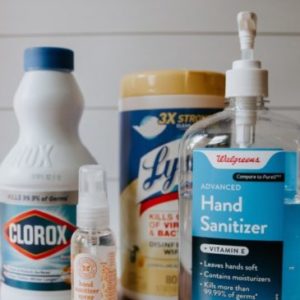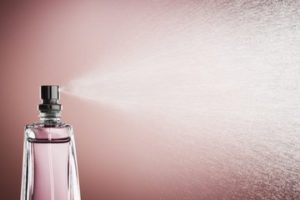This is a blog shared directly from the EWG website.
People with asthma can be exceptionally sensitive to air contaminants, including those in ordinary cleaning products.
In an asthma attack, the smooth muscles that line the airways to the lungs suddenly become swollen and inflamed and tighten up, obstructing or blocking the flow of air and causing chest tightness, wheezing, breathlessness and coughing. In people with the disorder, various circumstances can trigger an attack, including exposures to irritating or allergy-causing chemicals, stress, or exercise.
This chronic disorder has become increasingly common in recent decades for reasons that remain unclear. According to the U.S. Centers for Disease Control and Prevention, overall asthma prevalence in the United States increased from 7.3 percent to 8.4 percent from 2001 to 2010, with even higher prevalence among children.
Scientists and doctors believe that asthma may be caused by a combination of environmental and hereditary factors. Various health organizations and government agencies have been investigating the association of the disorder with the inhalation of certain chemicals, often in occupational settings. Authoritative bodies such as the Association of Occupational and Environmental Clinics have compiled lists of chemicals, known as asthmagens, that have been reported to cause asthma.
A 2009 study led by Jonathan Bernstein, a physician and leading asthma and allergy researcher at the University of Cincinnati College of Medicine, measured worsening symptoms in asthmatic women after they had completed housecleaning tasks (Bernstein 2009).
EWG’s assessment of more than 2,000 cleaning products found that 438 contain at least one chemical that the AOEC has identified as an asthmagen.
 Asthma in those who don’t typically have asthma?
Asthma in those who don’t typically have asthma?
A growing body of evidence suggests that using cleaning products can also cause asthma to develop in healthy people.
A 10-country study of more than 3,500 individuals who were initially free of asthma found that nine years later, those who used spray cleaners at least once a week to clean their homes had a 30-to-50 percent increased risk of developing asthma during the study period (Zock 2007). This association was linked primarily to commonly used spray products such as air fresheners, glass cleaners and furniture cleaning sprays. The risk increased the more often people used sprays or the greater the number of different sprays used.
The research team calculated that with the widespread use of spray cleaners and the high level of asthma risk, one in seven cases of adult asthma could be attributed to the use of these products (Zock 2007).
Cleaning products and the impact on children.
Preliminary findings also suggest that fetal exposure to household cleaning supplies may affect respiratory health. In a series of studies on parents and children, scientists at three British universities determined that children born to women who frequently used cleaning supplies in their homes while pregnant had a higher risk of persistent wheezing and reduced lung function (Sherriff 2005; Henderson 2008).
The increased risk of these respiratory symptoms persisted for at least eight years after in utero exposure and was independent of many other indoor air pollutant exposures and potential confounding factors.
Asthmagens or Respiratory Irritants
Asthmagens: ingredients that can cause or worsen asthma
- *2-Bromo-2-Nitropropane-1,3-Diol
- Alkyl Dimethyl Benzyl Ammonium Chloride
- Alkyl Dimethyl Ethylbenzyl Ammonium Chloride
- Didecyldimethylammonium Chloride
- Diethanolamine
- Dioctyl Dimethyl Ammonium Chloride
- Distearyldimonium Chloride
- *DMDM Hydantoin
- Ethanolamine
- Formaldehyde
- Glutaral
- Monoethanolamine Citrate
- Quaternium-15
- Quaternium-24
- Sodium Hypochlorite (Bleach)
- Sulfuric Acid
- Triethanolamine
* While not asthmagens themselves, these ingredients release formaldehyde, which is a recognized asthmagen.
 Worker studies highlight asthma risk.
Worker studies highlight asthma risk.
Extensive studies show clear links between on-the-job exposure to cleaning supplies and the development of asthma in workers who had never shown previous signs of the disease (Medina-Ramon 2005, 2006; Rosenman 2006; Arif 2009; Quirce 2010; Zock 2010).
Building custodians, teachers and health care workers are commonly exposed to cleaning supplies and are particularly afflicted by work-related asthma (Zock 2001; NIOSH 2004; Medina-Ramon 2005; Jaakkola 2006; Kogevinas 2007; Mazurek 2008). Many individuals recently diagnosed with asthma make a direct connection between exposure to certain cleaning products or chemicals and their condition. Studies have linked new cases of asthma to use of or exposure to spray cleaners, chlorine bleach sprays, disinfectants, air fresheners, drain cleaners, oven cleaners, furniture polish, carpet cleaners and floor waxing and stripping products (Nielsen 1999; Zock 2001, 2010; Medina-Ramon 2006; Obadia 2009; Quirce 2010; CDPH 2012).
A 2003 study led by Kenneth D. Rosenman, a professor of medicine at Michigan State University, found that 12 percent of the work-related asthma cases in four states were associated with exposure to cleaning products (Rosenman 2003). Four-fifths of the workers reporting work-related asthma linked to cleaning supplies had never suffered from the condition previously. Twenty-two percent of those afflicted worked as building custodians. In addition, seven of nine extensive epidemiological studies from several nations found an increased risk of asthma for people working as cleaners, with rates of asthma and asthma-type respiratory symptoms 1.5-to-2.5 times higher than in the general population (Rosenman 2006).
Chemicals can cause or worsen asthma
Several ingredients that are common in cleaning supplies are classified as asthmagens, meaning that they can cause asthma to develop in otherwise healthy people. In 2009, an EWG evaluation of 21 common school cleaners found that six of them emitted at least one of three common asthmagens into the air – formaldehyde, methyl methacrylate and styrene – when they were used as directed.
Many types of industrial chemicals can cause asthma. Those of greatest concern in cleaners include:
- Quaternary ammonium compounds, or “quats,” such as benzalkonium chloride, added as germ killers in antibacterial cleaning supplies and disinfecting air fresheners; they are also used as fabric softeners;
- Ethanolamines (mono-, di- and triethanolamine), commonly used to control product acidity (pH); they also act as detergents in many classes of cleaning products;
- Bleach (sodium hypochlorite) and ammonia (ammonium hydroxide), perhaps the most widely recognized cleaning ingredients in the world (AOEC 2012).
Many harsh acidic (low pH) or basic (high pH) cleaners aggravate asthma symptoms because they irritate the lungs. Moreover, if improperly mixed, bleach and acidic or ammonia-based cleaners can react to form extremely high concentrations of chlorine gas, which can cause a person to develop asthma after a single intense exposure (AOEC 2012). Other chemicals, like quats, bleach and ammonia, can cause asthma through allergic reactions that develop slowly after frequent, long-term exposures to lower concentrations of the substances (Bernstein 2006; AOEC 2012).
 Impurities and chemical reactions.
Impurities and chemical reactions.
Many ingredients in cleaning products evaporate easily, and some can react with other contaminants in the air to produce new, asthma-inducing chemicals. Some of these volatile organic compounds, or VOCs, have been measured at levels up to 100 times higher than those found outdoors and can exceed safety limits established for industrial facilities (Nazaroff 2006; EWG 2009; Bello 2010).
Airborne reactions involving volatile organic compounds can produce ozone, a powerful lung irritant. Long-term exposure to ozone during childhood can cause permanent lung damage (Kunzli 1997; Gilliland 2001). While there is little conclusive evidence that ozone alone can cause asthma, the subject merits more extensive study.
Pine- and citrus-based cleaners contain a class of volatile chemicals known as terpenes, which indirectly increase asthma risks. Terpenes may also be found in air fresheners and cleaners that contain other essential oils for fragrance. They react with ozone to form formaldehyde, an asthmagen and known human carcinogen.
The California Air Resources Board recommends that consumers avoid using citrus and pine oil cleaners, especially on warm, smoggy, high-ozone days (CARB 2008). Ozone-forming volatile organic compounds and ozone-reactive terpenes from pine and citrus oils may act together to increase formaldehyde air pollution. The combined effects on air quality of cleaning products that release these chemicals have not been studied and are a cause for concern.
 Childhood asthma is at an all-time high
Childhood asthma is at an all-time high
Surveys by the federal Centers for Disease Control and Prevention have detected a dramatic increase in childhood asthma across the country over the past few decades. At present, nearly 1 of every 10 children in the U.S. – 9.3 percent of the U.S. population under age 18 – has asthma (CDC 2008), up from 7.5 percent in 1996 and just 3.6 percent in 1980 (CDC 2006).
Childhood asthma is more common in African-American, Latino and low-income communities (CDC 2006; Babey 2007; Meng 2007). More asthma sufferers are being hospitalized than at any other time in American history, mirroring the documented trends in asthma prevalence (CDC 2006). The annual direct medical cost of asthma in children and adults for the year 2007 was estimated at $37 billion nationwide (Kamble 2009). Reducing in utero and childhood exposures to cleaning supplies that pollute the air with asthmagens and lung irritants may constitute an important investment in a healthy future.
 Mystery fragrance chemicals are a major allergy problem.
Mystery fragrance chemicals are a major allergy problem.
Some respiratory allergies may be set off by fragrances, which are complex chemical mixtures commonly used to scent air fresheners and cleaners, personal care products, and other consumer goods.
Fragrances are collectively considered among the top five allergens in the world (de Groot 1997; Jansson 2001). They can also trigger asthma attacks (Norback 1995; Millqvist 1996).
Researchers at the Universities of Washington and West Georgia who surveyed everyday Americans’ experiences with fragranced cleaning supplies found that nearly one in five suffered headaches, breathing difficulties or other problems when exposed to air fresheners (Caress 2009).
A study led by Alexandra Farrow of Brunel University in the United Kingdom linked air fresheners in the home to a higher incidence of diarrhea and earaches in infants and headaches and depression in their mothers (Farrow 2003).
A Swiss study published this year found that the use of air freshening sprays 4-7 days a week was associated with reduced heart rate variability, a marker of autonomic cardiac dysfunction (Mehta 2012). Because manufacturers routinely refuse to list individual ingredients in fragrances, independent researchers have difficulty conducting targeted studies to identify which fragrance chemicals raise the greatest concerns.
This blog further identifies the importance of chemical-free cleaning products not just to avoid asthma but for general health and well-being.
Related Posts:
Chemicals To Avoid In Self Care And Home Care Products
Non-toxic Yummy Toothpaste Anyone?
Triclosan: Is It Banned or Not Banned?
References:
1. AOEC (Association of Occupational and Environmental Clinics). 2012. Asthmagen compilation – AEOC exposures codes. www.aoec.org
2. Arif AA, Delclos GL, Serra C. 2009. Occupational exposures and asthma among nursing professionals. Occupational and Environmental Medicine 66(4): 274-278.
3. Babey SH, Hastert TA, Meng YY, Brown ER. 2007. Low-income Californians bear unequal burden of asthma. Policy brief (UCLA Center for Health Policy Research)(PB2007-1): 1-7.
4. Barron T, Sutherland L. 1999. Environmentally preferable janitorial products: Issues and opportunities. P2: Pollution Prevention Review 9(4): 17-25.
5. Basketter DA, Broekhuizen C, Fieldsend M, Kirkwood S, Mascarenhas R, Maurer K, et al. 2010. Defining occupational and consumer exposure limits for enzyme protein respiratory allergens under REACH. Toxicology 268(3): 165-170.
6. Bello A, Quinn MM, Perry MJ, Milton DK. 2010. Quantitative assessment of airborne exposures generated during common cleaning tasks: a pilot study. Environmental Health 9: 76.
7. Bernstein IL, Bernstein DI, Chan-Yeung M, Malo J-L. 2006. Definition and Classification of Asthma in the Workplace. In: Asthma in the Workplace, 3rd Ed (I. Leonard Bernstein MC-Y, Jean-Luc Malo, David I Bernstein, ed). New York: Taylor & Francis Group, 1-8.
8. Bernstein JA, Brandt D, Rezvani M, Abbott C, Levin L. 2009. Evaluation of cleaning activities on respiratory symptoms in asthmatic female homemakers. Annals of Allergy Asthma and Immunology 102(1): 41-46.
9. Bronstein AC, Spyker DA, Cantilena LR, Green JL, Rumack BH, Dart RC. 2011. 2010 Annual Report of the American Association of Poison Control Centers’ National Poison Data System (NPDS): 28th Annual Report. Clinical Toxicology 49(10): 910-941.
10. CARB (California Air Resources Board). 2008. Cleaning Products and Indoor Air Quality: Actions you can take to reduce exposures. www.arb.ca.gov/research/indoor/cleaning_products_fact_sheet-10-2008.pdf
11. Caress SM, Steinemann AC. 2009. Prevalence of fragrance sensitivity in the American population. Journal of Environmental Health 71(7): 46-50.
12. CDC (Centers for Disease Control and Prevention). 2006. The State of Childhood Asthma, United States, 1980-2005. Advance Data from Vital and Health Statistics, Number 381.
13. CDC (Centers for Disease Control and Prevention). 2008. Current Asthma Prevalence Percents by Age, United States: National Health Interview Survey, 2006: Centers for Disease Control and Prevention, National Center for Health Statistics.
14. CDHS (California Department of Health Services, now California Department of Public Health). 2007. Glycol Ethers: Fact Sheet: California Department of Health Services, Occupational Health Branch, Hazard Evaluation System and Information Service (HESIS).
15. CDPH (California Department of Public Health). 2012. Work-related Asthma Prevention Program, Unpublished data.
16. Chipinda I, Hettick JM, Siegel PD. 2011. Haptenation: chemical reactivity and protein binding. Journal of Allergy 2011: 839682.
17. Choi H, Schmidbauer N, Sundell J, Hasselgren M, Spengler J, Bornehag CG. 2010. Common household chemicals and the allergy risks in pre-school age children. PloS One 5(10): e13423.
18. Christensson JB, Matura M, Gruvberger B, Bruze M, Karlberg AT. 2010. Linalool–a significant contact sensitizer after air exposure. Contact Dermatitis 62(1): 32-41.
19. Cordier S, Bergeret A, Goujard J, Ha MC, Ayme S, Bianchi F, et al. 1997. Congenital malformation and maternal occupational exposure to glycol ethers. Occupational Exposure and Congenital Malformations Working Group. Epidemiology 8(4): 355-363.
20. De Groot AC, Frosch PJ. 1997. Adverse reactions to fragrances. A clinical review. Contact Dermatitis 36(2): 57-86.
21. ECHA (European Chemicals Agency). 2008. Transitional Annex XV Dossier, Substance Name: Boric acid (Boric acid crude natural). Submitted by Austria, December 2008.
22. ECHA (European Chemicals Agency). 2010. Member State Committee Draft Support Document for Identification of Boric Acid as a Substance of Very High Concern Because of its CMR Properties. June 2010.
23. ECHA (European Chemicals Agency). 2011. Classification and Labeling Inventory Database. echa.europa.eu/web/guest/information-on-chemicals/cl-inventory-database.
24. European Commission. 2007. European Union Risk Assessment Report: Perboric acid, sodium salt. Including Addendum 2007. European Chemicals Bureau, Institute for Health and Consumer Protection. Third Priority List, Volume 71.
25. European Union. 2008. Decision No 1348/2008/EC of the European Parliament and of the Council of 16 December 2008 amending Council Directive 76/769/EEC as regards restrictions on the marketing and use of 2-(2- methoxyethoxy)ethanol, 2-(2-butoxyethoxy)ethanol, methylenediphenyl diisocyanate, cyclohexane and ammonium nitrate. Published in the Official Journal of the European Union, L 348, on December 24, 2008.
26. EPA (U.S. Environmental Protection Agency). 2000. Glycol Ethers Hazard Summary: U.S. Environmental Protection Agency, Air Toxics Division. January 2000.
27. EPA (U.S. Environmental Protection Agency). 2006. Boric Acid/Sodium Borate Salts: HED Chapter of the Tolerance Reassessment Eligibility Decision Document (TRED). PC Codes: 011001 (boric acid), 011102 (sodium tetraborate decahydrate), 011110 (sodium tetraborate pentahydrate), 011112 (sodium tetraborate anhydrous), 011103 (disodium octaborate tetrahydrate), 011107 (disodium octaborate anhydrous), 011104 (sodium metaborate).
28. Case # 0024, DP Barcode D320894. Regulatory Action: Tolerance Reassessment Progress and Interim Risk Management Decision.
29. EPA (U.S. Environmental Protection Agency). 2010. Toxicological Review of 1,4-Dioxane (CAS No. 123-91-1) in Support of Summary Information on the Integrated Risk Information System (IRIS). U.S. Environmental Protection Agency. August 2010.
30. EWG (Environmental Working Group). 2009. Greener School Cleaners = Healthier Kids. www.ewg.org/schoolcleaningsupplies
31. Farrow A, Taylor H, Northstone K, Golding J. 2003. Symptoms of mothers and infants related to total volatile organic compounds in household products. Archives of Environmental Health 58(10): 633-641.
32. Gilliland FD, Berhane K, Rappaport EB, Thomas DC, Avol E, Gauderman WJ, et al. 2001. The effects of ambient air pollution on school absenteeism due to respiratory illnesses. Epidemiology 12(1): 43-54.
33. Henderson J, Sherriff A, Farrow A, Ayres JG. 2008. Household chemicals, persistent wheezing and lung function: effect modification by atopy? European Respiratory Journal 31(3): 547-554.
34. Herdt-Losavio ML, Lin S, Chapman BR, Hooiveld M, Olshan A, Liu X, et al. 2010. Maternal occupation and the risk of birth defects: an overview from the National Birth Defects Prevention Study. Occupational and Environmental Medicine 67(1): 58-66.
35. Jaakkola JJ, Jaakkola MS. 2006. Professional cleaning and asthma. Current Opinion in Allergy and Clinical Immunology 6(2): 85-90.
36. Jansson T, Loden M. 2001. Strategy to decrease the risk of adverse effects of fragrance ingredients in cosmetic products. American Journal of Contact Dermatitis 12(3): 166-169.
37. Kamble S, Bharmal M. 2009. Incremental direct expenditure of treating asthma in the United States. Journal of Asthma 46(1): 73-80.
38. Karlberg AT, Bergstrom MA, Borje A, Luthman K, Nilsson JL. 2008. Allergic contact dermatitis–formation, structural requirements, and reactivity of skin sensitizers. Chemical Research in Toxicology 21(1): 53-69.
39. Kogevinas M, Zock JP, Jarvis D, Kromhout H, Lillienberg L, Plana E, et al. 2007. Exposure to substances in the workplace and new-onset asthma: an international prospective population-based study (ECRHS-II). Lancet 370(9584): 336-341.
40. Kunzli N, Lurmann F, Segal M, Ngo L, Balmes J, Tager IB. 1997. Association between lifetime ambient ozone exposure and pulmonary function in college freshmen–results of a pilot study. Environmental Research 72(1): 8-23.
41. Laslo-Baker D, Barrera M, Knittel-Keren D, Kozer E, Wolpin J, Khattak S, et al. 2004. Child neurodevelopmental outcome and maternal occupational exposure to solvents. Archives of Pediatrics & Adolescent Medicine 158(10): 956-961.
42. Liskowsky J, Geier J, Bauer A. 2011. Contact allergy in the cleaning industry: analysis of contact allergy surveillance data of the Information Network of Departments of Dermatology. Contact Dermatitis 65(3): 159-166.
43. Magnano M, Silvani S, Vincenzi C, Nino M, Tosti A. 2009. Contact allergens and irritants in household washing and cleaning products. Contact Dermatitis 61(6): 337-341.
44. Mazurek JM, Filios M, Willis R, Rosenman KD, Reilly MJ, McGreevy K, et al. 2008. Work-related asthma in the educational services industry: California, Massachusetts, Michigan, and New Jersey, 1993-2000. American Journal of Industrial Medicine 51(1): 47-59.
45. McKenzie LB, Ahir N, Stolz U, Nelson NG. 2010. Household cleaning product-related injuries treated in US emergency departments in 1990-2006. Pediatrics 126(3): 509-516.
46. Medina-Ramon M, Zock JP, Kogevinas M, Sunyer J, Basagana X, Schwartz J, et al. 2006. Short-term respiratory effects of cleaning exposures in female domestic cleaners. European Respiratory Journal 27(6): 1196-1203.
47. Medina-Ramon M, Zock JP, Kogevinas M, Sunyer J, Torralba Y, Borrell A, et al. 2005. Asthma, chronic bronchitis, and exposure to irritant agents in occupational domestic cleaning: a nested case-control study. Occupational and Environmental Medicine 62(9): 598-606.
48. Mehta AJ, Adam M, Schaffner E, Barthelemy JC, Carballo D, Gaspoz JM, et al. 2012. Heart rate variability in association with frequent use of household sprays and scented products in SAPALDIA. Environmental Health Perspectives 120(7): 958-964.
49. Meng YY, Babey SH, Hastert TA, Brown ER. 2007. California’s racial and ethnic minorities more adversely affected by asthma. Policy brief (UCLA Center for Health Policy Research)(PB2007-3): 1-7.
50. Millqvist E, Lowhagen O. 1996. Placebo-controlled challenges with perfume in patients with asthma-like symptoms. Allergy 51(6): 434-439.
51. Nazaroff WW, Coleman BK, Destaillats H, Hodgson AT, Liu D-L, Lunden MM, et al. 2006. Indoor Air Chemistry: Cleaning Agents, Ozone and Toxic Air Contaminants: Prepared for the California Air Resources Board and the California Environmental Protection Agency: California Air Resources Board.
52.NTP (National Toxicology Program). 2000. NTP Toxicology and Carcinogenesis Studies 2-Butoxyethanol (CAS NO. 111-76-2) in F344/N Rats and B6C3F1 Mice (Inhalation Studies). National Toxicology Program technical report series 484: 1-290.
53. Nielsen J, Bach E. 1999. Work-related eye symptoms and respiratory symptoms in female cleaners. Occupational Medicine (Oxford, England) 49(5): 291-297.
54. NIOSH (National Institute for Occupational Safety and Health). 2004. Discussion: Work-Related Asthma. NIOSH Safety and Health Topic: Occupational Respiratory Disease Surveillance. www.cdc.gov/niosh/topics/surveillance/ords/FeaturedDiscussion/ORDS-200410.html
55. Norback D, Bjornsson E, Janson C, Widstrom J, Boman G. 1995. Asthmatic symptoms and volatile organic compounds, formaldehyde, and carbon dioxide in dwellings. Occupational and Environmental Medicine 52(6): 388-395.
56. Obadia M, Liss GM, Lou W, Purdham J, Tarlo SM. 2009. Relationships between asthma and work exposures among non-domestic cleaners in Ontario. American Journal of Industrial Medicine 52(9): 716-723.
57. Odabasi M. 2008. Halogenated volatile organic compounds from the use of chlorine-bleach-containing household products. Environmental Science & Technology 42(5): 1445-1451.
58. Pechter E, Azaroff LS, Lopez I, Goldstein-Gelb M. 2009. Reducing hazardous cleaning product use: a collaborative effort. Public Health Report 124 Suppl 1: 45-52.
59. Quirce S, Barranco P. 2010. Cleaning agents and asthma. Journal of Investigational Allergology and Clinical Immunology 20(7): 542-550.
60. Rosenman KD. 2006. Cleaning products-related asthma. Clinical Pulmonary Medicine 13(4): 221-228.
61. Rosenman KD, Reilly MJ, Schill DP, Valiante D, Flattery J, Harrison R, et al. 2003. Cleaning products and work-related asthma. Journal of Occupational and Environmental Medicine / American College of Occupational and Environmental Medicine 45(5): 556-563.
62. Sarlo K, Kirchner DB, Troyano E, Smith LA, Carr GJ, Rodriguez C. 2010. Assessing the risk of type 1 allergy to enzymes present in laundry and cleaning products: evidence from the clinical data. Toxicology 271(3): 87-93.
63. Sherriff A, Farrow A, Golding J, Henderson J. 2005. Frequent use of chemical household products is associated with persistent wheezing in pre-school age children. Thorax 60(1): 45-49.
64. Steinman D. 2010. Results of Testing for 1,4-Dioxane by Gas Chromatography/Mass Spectrometry.
65. Till C, Koren G, Rovet JF. 2001. Prenatal exposure to organic solvents and child neurobehavioral performance. Neurotoxicology and Teratology 23(3): 235-245.
66. Till C, Westall CA, Koren G, Nulman I, Rovet JF. 2005. Vision abnormalities in young children exposed prenatally to organic solvents. Neurotoxicology 26(4): 599-613.
67. Van Rooy FG, Houba R, Palmen N, Zengeni MM, Sander I, Spithoven J, et al. 2009. A cross-sectional study among detergent workers exposed to liquid detergent enzymes. Occupational and Environmental Medicine 66(11): 759-765.
68. Vanhanen M, Tuomi T, Tiikkainen U, Tupasela O, Voutilainen R, Nordman H. 2000. Risk of enzyme allergy in the detergent industry. Occupational and Environmental Medicine 57(2): 121-125.
69. Weeks JA, Harper RA, Simon RA, Burdick JD. 2010. Assessment of sensitization risk of a laundry pre-spotter containing protease. Cutaneous and Ocular Toxicology 30(4): 272-279.
70. Wibbenmeyer LA, Morgan LJ, Robinson BK, Smith SK, Lewis RW, 2nd, Kealey GP. 1999. Our chemical burn experience: exposing the dangers of anhydrous ammonia. The Journal of Burn Care & Rehabilitation 20(3): 226-231.
71. Zock JP, Kogevinas M, Sunyer J, Almar E, Muniozguren N, Payo F, et al. 2001. Asthma risk, cleaning activities and use of specific cleaning products among Spanish indoor cleaners. Scandinavian Journal of Work, Environment & Health 27(1): 76-81.
72. Zock JP, Plana E, Anto JM, Benke G, Blanc PD, Carosso A, et al. 2009. Domestic use of hypochlorite bleach, atopic sensitization, and respiratory symptoms in adults. The Journal of Allergy and Clinical Immunology 124(4): 731-738 e731.
73. Zock JP, Plana E, Jarvis D, Anto JM, Kromhout H, Kennedy SM, et al. 2007. The use of household cleaning sprays and adult asthma: an international longitudinal study. American Journal of Respiratory and Critical Care Medicine 176(8): 735-741.
74. Zock JP, Vizcaya D, Le Moual N. 2010. Update on asthma and cleaners. Current Opinion in Allergy and Clinical Immunology 10(2): 114-120.
75. Zota AR, Aschengrau A, Rudel RA, Brody JG. 2010. Self-reported chemicals exposure, beliefs about disease causation, and risk of breast cancer in the Cape Cod Breast Cancer and Environment Study: a case-control study. Environmental Health 9: 40.







